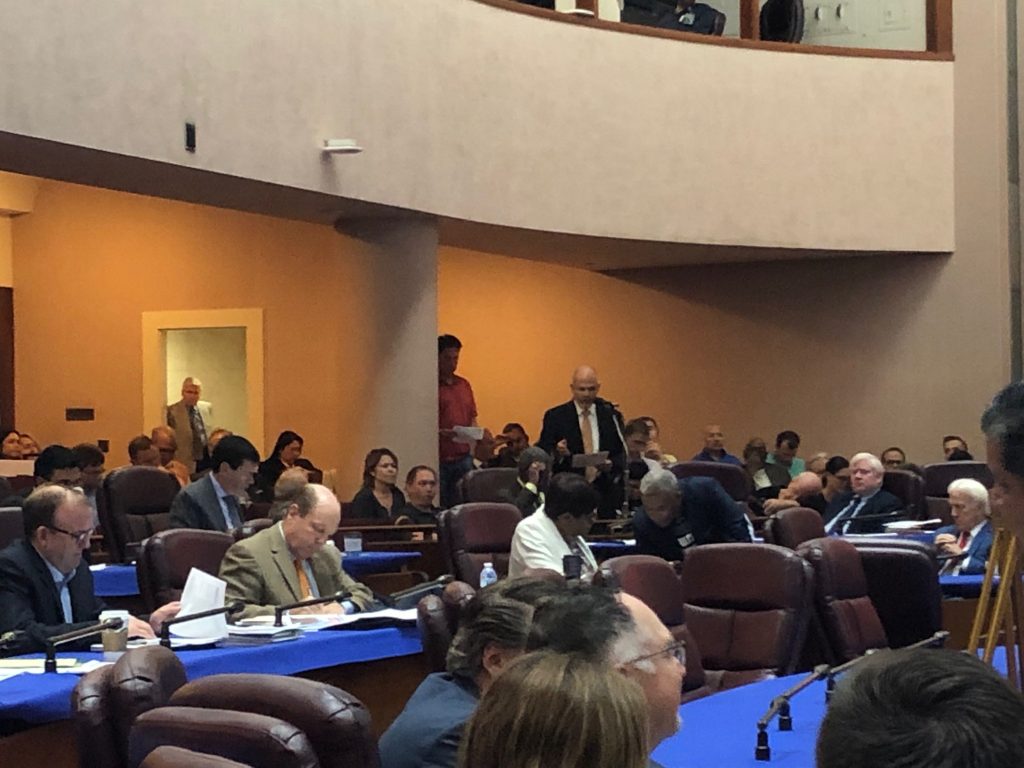-
Aldermen advance Kinzie Corridor changes, defend 'protected area' for industrial businesses

Roger Romanelli, of the Fulton Market Association, urged aldermen to rethink the changes to allow more community input. [Alex Nitkin/The Daily Line]
Aldermen on Tuesday advanced a sweeping initiative that would open the door for some offices and retailers to move into the industrial area west of Fulton Market, despite protests from some business owners who called the plan overly restrictive.
The changes (O2019-5606) were first proposed last year by the city’s Department of Planning and Development under former Mayor Rahm Emanuel as a way to invite more businesses into the Kinzie Industrial Corridor, which is bounded by Ogden Avenue, Sacramento Boulevard, Lake Street and Grand Avenue, while maintaining the area as a predominantly industrial zone.The amendments to Planned Manufacturing District 4 prevent any new “heavy industrial” users, like shipping container storage or waste-related facilities, from opening anywhere in the district. They also bar any new daycares, restaurants or medical offices from opening in the district west of Ashland Avenue, which will be called PMD 4A.
But small offices and some retailers, including restaurants, will be able to open inside a smaller sector between Ogden and Ashland Avenue, an area to be known as PMD 4B.
The change will allow offices larger than 9,000 square feet to open in PMD 4B. Restaurants up to 4,000 square feet in size could also operate in the smaller eastern section, and owners may ask the Zoning Board of Appeals for permission to open restaurants as large as 12,000 square feet.
The idea is to create a “buffer” between the booming Fulton Market restaurant district and a “reinforced” light industrial hub whose businesses would be insulated from other kinds of users, according to Patrick Murphey, an administrator with the Department of Planning and Development.
But residential development will remain forbidden throughout the district under the new zoning. And the area’s density will remain unchanged with a 3.0 Floor Area Ratio, meaning that new buildings would not be able to reach more than a few stories tall.
During a public comment period on Tuesday, multiple neighbors and business owners called the rezone a missed opportunity to ride the wave of economic opportunity gushing west from Fulton Market.
Roger Romanelli, the executive director of the Fulton Market Association, said “the majority of the community” wants the Planned Manufacturing District to be totally repealed between Ashland and Ogden, the way a similar district was repealed inside Fulton Market in 2017.
“There is 1 million square feet of available space and land in the PMD, and we need to fill up the West Side with businesses,” Romanelli said. “We have seen in Fulton Market that commercial businesses and industrial businesses can absolutely co-exist and thrive.”
Romanelli and other critics also said city planners had not accepted enough community input, having held two public meetings since the plan was introduced last October. The Chicago Plan Commission approved the rezone in May.
But Murphey called the plan “the culmination of five years of planning and analysis by the city,” adding that he and other planning officials “met and otherwise communicated with numerous, various land and business owners about the planning process and ordinance.”
City officials also made some tweaks to the plan in response to neighborhood feedback, Murphey said.
For example, the version approved on Tuesday will lump businesses on the west side of Ashland Avenue into PMD 4B, the more inclusive eastern subsection. And indoor sports and recreation facilities were added to the list of uses permitted in 4B.
Ald. Walter Burnett (27), whose ward includes most of the Kinzie Industrial Corridor, lauded the rezoning plan on Tuesday, saying it would protect industrial businesses from being “encroached upon” by residential development.
“It’s hard for [industrial] businesses like that to move,” Burnett said. “They moved to this area because it was a protected area, so we’re going to keep it a protected area.”
The measure is now set for final approval by the City Council on Wednesday.
Aldermen also took the following actions during Tuesday’s zoning committee meeting:-
- O2019-5544 — The committee advanced a zoning change to support a 13-story, 310-room hotel proposed by Convexity Properties for a vacant lot at 180 W. Randolph St. in the 42nd Ward.
-
- O2019-4105 — The committee advanced a zoning change to allow a 20-story office building at 301 W. Huron St. and an eight-story addition to an existing office building at 308 W. Erie St. in the 42nd Ward. Both buildings are proposed by North Wells Capital.
-
- O2019-5535 — The committee advanced a zoning change to support an 84-unit residential building proposed by Cedar Street Companies at 4750 N. Winthrop Ave. in the 46th Ward, across the street from Cedar Street’s Lawrence House apartment complex.
-
- O2019-5540 — The committee deferred a zoning change that would permit a 50-unit transit-oriented development at 5356 N. Sheridan Road at the request of Ald. Harry Osterman (48).
-
- O2019-5570 — The committee deferred a proposal by North Park Ventures to build a 19-story hotel and office building at 800 W. Lake Street in the 27th Ward because the proposal has not been approved by the Chicago Plan Commission.
In other action, aldermen advanced Mayor Lori Lightfoot’s appointments to the City Colleges Board of Trustees, a tax break for a polluted piece of property that has been transformed into a veterinary center in the 33rd Ward, a loan restructuring for a North Side senior apartment center as well as eight appointments to Special Service Area boards across the city, as detailed in The Daily Line’s preview.
-
Do you like this page?













